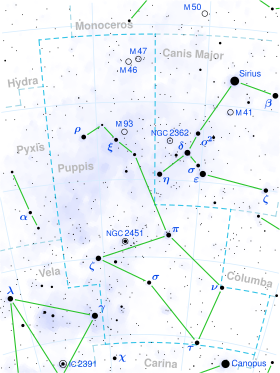
ν Persei, Latinized as Nu Persei, is a single star and a suspected variable in the northern constellation of Perseus. It has a yellow-white hue and is visible to the naked eye with an apparent visual magnitude of 3.80. This object is located approximately 560 light-years from the Sun based on parallax but is drifting closer with a radial velocity of −12 km/s.
Zeta Monocerotis, Latinized from ζ Monocerotis, is a single, yellow-hued star in the constellation Monoceros. It has an apparent visual magnitude of 4.33, which is bright enough to be visible to the naked eye. The annual parallax shift as measured during the Hipparcos mission is 3.08 milliarcseconds, which provides a rough distance estimate of 1,060 light years. It is moving away from the Sun with a radial velocity of +30 km/s.

17 Monocerotis is a single star located around 490 light years away from the Sun in the equatorial constellation of Monoceros. It is visible to the naked eye as a faint, orange-hued star with an apparent visual magnitude of 4.77. The star is moving away from the Earth with a heliocentric radial velocity of +46 km/s.

19 Monocerotis is a single, variable star in the equatorial constellation of Monoceros, located approximately 1,220 light years away from the Sun based on parallax. It has the variable star designation V637 Monocerotis, while 19 Monocerotis is the Flamsteed designation. This object is visible to the naked eye as a faint, blue-white hued star with a baseline apparent visual magnitude of 5.00. It is receding from the Earth with a heliocentric radial velocity of +25 km/s.

HD 103079 is a class B4V star in the constellation Musca. Its apparent magnitude is 4.89 and it is approximately 362 light years away from Earth based on parallax. It is a member of the Lower Centaurus–Crux subgroup of the Scorpius–Centaurus association, a group of predominantly hot blue-white stars that share a common origin and proper motion across the galaxy.

42 Orionis is a class B1V star in the constellation Orion. Its apparent magnitude is 4.59 and it is approximately 900 light years away based on parallax.

31 Pegasi is a single star in the northern constellation of Pegasus. It is visible to the naked eye as a dim, blue-white hued point of light with a baseline apparent visual magnitude of 4.99. It is located approximately 1,600 light years away from the Sun based on parallax, but is drifting closer with a radial velocity of −5.3 km/s.

17 Persei is a single star in the northern constellation of Perseus, located about 390 light years away from the Sun. It is visible to the naked eye as a faint, orange-hued star with an apparent visual magnitude of 4.53. This object is moving further from the Earth at a heliocentric radial velocity of +13 km/s.

HD 20468 is a class K2II star in the constellation Perseus. Its apparent magnitude is 4.82 and it is approximately 1180 light years away based on parallax.

HD 63922 is a class B0III star in the constellation Puppis. Its apparent magnitude is 4.11 and it is approximately 1600 light years away based on parallax.

HD 64760 is a class B0.5 supergiant star in the constellation Puppis. Its apparent magnitude is 4.24 and it is approximately 1,660 light years away based on parallax.

NV Puppis, also known as υ1 Puppis, is a class B2V star in the constellation Puppis. Its apparent magnitude is 4.67 and it is approximately 800 light years away based on parallax.

19 Puppis is a binary star system in the southern constellation of Puppis, near the northern border with Hydra and Monoceros. It is visible to the naked eye as a faint, yellow-hued star with an apparent visual magnitude of 4.72. The system is located approximately 177 light years away from the system based on parallax. It is receding from the Earth with a heliocentric radial velocity of +36 km/s, having come to within 31 light-years some 1.4 million years ago.

HD 70555 is a class K2.5II-III star in the constellation Puppis. Its apparent magnitude is 4.83 and it is approximately 1,010 light years away based on parallax.

HD 61831 is a class B2.5V star in the constellation Puppis. Its apparent magnitude is 4.84 and it is approximately 556 light years away based on parallax.

HD 51799 is a class M1III star in the constellation Puppis. Its apparent magnitude is 4.95 and it is approximately 860 light years away based on parallax.

HD 50235 is a class K5III star located approximately 811 light years away, in the constellation Puppis. Its apparent magnitude is 4.99. HD 50235 made its closest approach to the Sun 7.8 million years ago, at the distance of 137 light years, during which it had an apparent magnitude of 1.13.

HD 167818 is a class K3II star in the constellation Sagittarius. Its apparent magnitude is 4.66 and it is approximately 760 light years away based on parallax.

21 Sagittarii is a binary star system in the southern zodiac constellation of Sagittarius. It is visible to the naked eye as a faint point of light with a combined apparent visual magnitude of 4.81. The system is located approximately 410 light years away from the Sun based on parallax. It is moving closer to the Earth with a heliocentric radial velocity of −11.80 km/s.

HD 172910 is a class B2.5V star in the constellation Sagittarius. Its apparent magnitude is 4.87 and it is approximately 467 light years away based on parallax.







